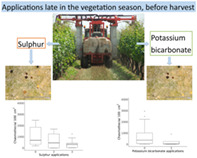- Record: found
- Abstract: found
- Article: found
Efficiency of inorganic fungicides against the formation of Erysiphe necator chasmothecia in vineyards

Read this article at
Abstract
BACKGROUND
A reduction in chasmothecia, an important inoculum of grape powdery mildew ( Erysiphe necator Schwein.), is essential for disease control in vineyards; the use of fungicides during the formation of chasmothecia on vine leaves, late in the growing season, may accomplish this. Inorganic fungicides, such as sulphur, copper, and potassium bicarbonate, are very useful for this purpose because of their multisite mode of action. The aim of this study was to evaluate chasmothecia reduction using different fungicide applications late in the growing season in commercially managed vineyards and in an exact application trial.
RESULTS
Chasmothecia on vine leaves were reduced in commercial vineyards by four copper ( P = 0.01) and five potassium bicarbonate ( P = 0.026) applications. The positive effect of potassium bicarbonate was also confirmed in the application trial, where two applications showed lower chasmothecia numbers than the control ( P = 0.002).
CONCLUSION
The application of inorganic fungicides reduced the amount of chasmothecia as the primary inoculum source. Potassium bicarbonate and copper are of further interest for disease control as these fungicides can be used by organic and conventional wine growers. The application of these fungicides should be carried out as late as possible before harvest to reduce chasmothecia formation and, consequently, the potential for powdery mildew infestation in the subsequent season. © 2023 The Authors. Pest Management Science published by John Wiley & Sons Ltd on behalf of Society of Chemical Industry.
Abstract
Related collections
Most cited references55
- Record: found
- Abstract: not found
- Article: not found
A protocol for data exploration to avoid common statistical problems
- Record: found
- Abstract: not found
- Article: not found
